We truck enthusiasts have a passion for knives, so we decided to do something a bit different: a behind-the-scenes tour of the American-made Pro-Tech Knives headquarters and manufacturing facility in Placentia, California. The Truck Show Podcast is proudly presented by Nissan in association with Banks Power and AMSOIL.
The following transcription of The Truck Show Podcast was generated using a speech recognition software, and will contain errors. Please review the timestamp and listen to the corresponding audio for accuracy.
Quick Link to Previous Episodes
Sean P. Holman (0s):
Hey, Lighting, Have, You, Heard.
Intro (2s):
No.
Jay “Lightning” Tilles (3s):
No, I don’t think so.
Intro (7s):
The truck show. We’re gonna show you what we know. We’re gonna answer What? The truck. Because truck rides with The truck show. We have the lifted We have the lowered and everything in between. We’ll talk about trucks that run on diesel and the ones that run on gasoline. The truck show, The truck show. The truck show. Whoa Whoa. It’s The truck show with your hosts Lightning and Holman.
Sean P. Holman (44s):
This episode of The Truck Show Podcast Have You Heard is proudly presented by Nissan with the Frontier Titan and Titan Xd. Nissan has a truck for every need, along with the legendary Nissan durability. Test Drive. your next truck at a local Nissan dealer today, Or point your browser to Nissan usa dot com where you can use the build and price tool to configure a Nissan truck that fits your lifestyle.
Jay “Lightning” Tilles (1m 4s):
And when you’re thinking about adding power or improving fuel economy, Banks has over 65 years of experience Whether. It’s cold air intakes or exhaust systems tuning, throttle control charge, air cooling, lubrication components, and much more. No one offers smarter, safer, 50 state emissions compliant performance parts than Gale Banks. You’ll find the best engineered parts for your truck at banks power dot com. And
Sean P. Holman (1m 27s):
When you’re looking for quality full synthetic lubrication for your truck, AMS oil has you covered with motor oil lubricants and protectants grease additives and more. AMS oil, synthetic lubricants deliver wear protection, engine cleanliness and fuel efficiency that conventional oils simply can’t match. Find out how AMS oil synthetic lubricants can save you money and time by helping your vehicles run better and last longer than with conventional oils at ams oil dot com. When it comes to Lubrication AM oil is the leader in synthetics, Have You, Heard
Jay “Lightning” Tilles (1m 58s):
Holman. From what I understand, you were recently at a a knife manufacturer or something like that. Where were you and what were you doing? So
Sean P. Holman (2m 6s):
This is gonna be a little bit different than what we normally do on the podcast. But I thought it was cool ’cause a you love shop tours and manufacturing in a room filled with 20 CNC machines. I do. You love American manufacturing? I do. So does our audience and everybody who is listening to the show probably has a pocket knife. You might have your favorite brands, you might have a bench made or Spider Co or a Gerber or whatever, but many of you may not have heard of one of the highest quality knife manufacturers here in the United States named ProTech. It’s family owned business. They’re like 20 minutes from the, from the pod shed. And I was invited to go there. I was doing some stuff with OVR and they offered me a tour. My buddy Matt over there said, Hey, you know, we’ll give you a tour, Michael, why don’t I just record it for the podcast?
Sean P. Holman (2m 47s):
And so what
Jay “Lightning” Tilles (2m 48s):
Did you know about them before you left?
Sean P. Holman (2m 50s):
I mean, I’m a customer love their knives. Oh, you,
Jay “Lightning” Tilles (2m 52s):
Oh, I didn’t know that you owned one.
Sean P. Holman (2m 53s):
No. Yeah. Super, super high quality, high end. They’ve got knives that are up in the tens of thousands of dollars
Holman & Lightning (2m 59s):
And they’ve got knives that are 2 99 and and everything in between. And they make just fantastic cutlery. They’re known for their autos. Spring assist flippers got to walk through the shop. And the level of craftsmanship is like old world. I mean these are, these are knives that have some of the best action. They have ball bearing pivots and all sorts of really unique materials like mastodon bones and bronze and all sorts of stuff. Is that legal? It’s, it’s, yeah. A mother of pearl that just, no, no. Hold on. Gravy from a mastodon. Why don’t you just listen to the interview? Okay. Alright. All right. So I’m at Pro Tech Knives here in central California with Matt Ewen and this is kind of a treat for your truck guys.
Holman & Lightning (3m 43s):
So we’re doing some other stuff and I know everybody who drives Truck Off Road. You all have pocket knives, I have a pocket knife. And over time I’ve gone through all the famous brands, I’ve owned them all. And the one I keep coming back to is ProTech. And if you’ve never heard of ProTech before, these guys have been around since 99. Family owned business, everything’s made in-House here in Orange County, California. And I just had an opportunity to, to come see Matt today. So I figured, you know what, he’s gonna gimme a tour of all the machinery. I thought I’d take you along. So you want to introduce us to ProTech?
Matt (4m 15s):
Hey, thanks for having me Sean. Yeah, so Protech’s been in business for 25 years. It’s act our 25 year anniversary as of this bla show Atlanta. So we’re in our only facility, which is here in California in Placentia. We have about 35 employees. So we’re definitely a rarity here for California producing things in general and in particular making pocket knives of all things we like to say. We make things behind enemy lines, which has really become our slogan these days. Unofficially. That’s awesome. I love it. We specialize in fully automatic knives, both California legal models, military law enforcement models, and really everything in between. And our range spans from, you know, a knife that you can get that’s a hundred dollars made by our team here in house to something that’s, you know, up to $14,000.
Matt (4m 58s):
That’s also made here in our facility. Everything is CNC, machined, CAD drawings, machined, assembled, polished, sharpened, packaged, all in this one building. So I’ll,
Holman & Lightning (5m 8s):
Let me add, I’ll add two things to that. Number one, I love your flippers. Thank you. You guys make an amazing flipper. Guys, if you haven’t felt the tolerance difference between one of their flippers and one of their competitors, everything they use here is like the highest quality of everything. And Matt was talking about the higher end knives that are 10, $14,000. We’re talking about Damascus steel and pearl handles and titanium and all, all sorts of cool different materials put together. The other thing I was gonna say, you mentioned California legal automatic. So a lot of people think California automatics are, are all illegal, but that’s not true. So walk us through what’s, what makes a California compliant automatic. Sure. So there,
Matt (5m 46s):
25 years ago on the founder Dave Wattenberg kitchen table, he made the first ever ProTech, which was called the runt. It’s a sub two inch automatic knife. If you look under the California laws, there is a small little section that says if your automatic knife, which means you press a button and it springs open, if the blade is under two inches, it is not deemed an automatic knife and therefore California legal. And so 25 years ago we made that knife, we called it the run sold out. It’s been an amazing model for us. We still make today as a Generation five model and along with a couple other California legal knives, that’s something that has really expanded our company and now we’re really known for the more fuller sized autos and even the, the flippers that you talked about.
Matt (6m 28s):
But we still make those. It’s a, it’s a huge model and a successor for us as well. I kind of feel like we’re giving your audience blue balls just because we’re talking about knives. We’re in a machine shop. I, I was just telling you we’re, we’re peppering for our big show Abla Show Atlanta, which is in June and it is the big show is probably your guys’ version of sema. I’d imagine.
Holman & Lightning (6m 46s):
So. So if you guys, if you guys can imagine you’re standing in a warehouse and in that warehouse is so chocked bowl of CC machines,
Matt (6m 54s):
There’s a guy delivering a CC machine as we speak, walking past us. I
Holman & Lightning (6m 57s):
I, I passed The truck in the, in the parking lot and I was like, are they getting a new machine? I mean, how many CC machines do you guys have here?
Matt (7m 4s):
Oh man, I
Holman & Lightning (7m 5s):
It’s gotta be 20. Yeah,
Matt (7m 8s):
We’re, we’re we’re close to around there. Yeah,
Holman & Lightning (7m 9s):
I mean it’s, it’s insane. And this place is awesome. You can’t imagine how much machines they have packed into this space. But you want to give us a, give us a tour?
Matt (7m 19s):
Sure, I’ll walk us through it. I mean you’re gonna have to describe the audience what we’re seeing as well, but yeah, it’s gonna be hard to expire. So our, on our one side over here, we’re stocking all of our aluminum parts. So our whole production revolves around our steel blades. To go from a sheet of steel that’s untreated, all American made resources to a finished blade that is ready for assemble is about three months. But a lot of the handles that we do, which are CNC pieces, developed material, we try to keep as much of that raw aluminum material on deck as possible. So the minute a blade is done, we can make these handles, which are a very quick cycle for us. Generally the aluminum we use here is 60, 61 and 70 75. We have great aluminum,
Holman & Lightning (7m 58s):
What am I holding in my hand right now? That
Matt (7m 60s):
Is the only non-American material we use here in the building. Okay. That is ampco twist bronze.
Holman & Lightning (8m 5s):
It’s awesome. It’s literally a little rectangle of bronze and it’s so heavy and dense.
Matt (8m 12s):
It’s absurdly tanky. Oh dude. So it’s, the actual name of it is Amco aluminum bronze. It’s about 10% aluminum. They took out all of the, I want to say it was the zinc in it
Holman & Lightning (8m 23s):
Makes it for more durability so it doesn’t like it adds
Matt (8m 25s):
More durability age over time or It was, yes. And it was originally made for the marine industry so the hold of boats wouldn’t equate and turn green and rust away. It will still pat over time and take a lovely patina. We
Holman & Lightning (8m 37s):
Actually found it but not like a corroded like it won’t or something like that. Yeah, but it’ll still your, your oils of your hand and oxidation will still give it kind of the richer, deeper color.
Matt (8m 46s):
Exactly. And so you can kind of age as you have that knife as well. Reason being it’s not American made is because frankly the Swiss do it better. The other big, you know, buyer of that Amco Swiss bronze is Rolex and Tudor and I imagine if it’s good enough for them and good enough for the holes of a vessel, it’s probably good enough for your pocket knife handle as well. So over here is kinda where we stock all of our ready to go handle materials. Again, everything we do is CNC machine. We’re not stamping or 3D machining everything. We are machining what we don’t want away to have a perfect handle where every block material you see here is one half of a handle piece. And so we try to make sure that as soon as that blade is done, the handles are not too far behind it. And so if we keep walking over here, you can see where we stalk all of our steel.
Matt (9m 29s):
Again, American made, we get all of ours from Niagara Crucible metallurgy, also known as Crucible. They’re a manufacturer
Holman & Lightning (9m 36s):
By way. I was just gonna say that’s a huge thing. So in the automotive market there’s several manufacturers who claim either made in the USA or assembled in the USA, what they don’t get their steal from the USA. And there’s a few companies that actually could track through the, the numbers, through the serial numbers of the shipment all the way back that they had American steel. And sometimes when You buy steel on the open marketplace, you don’t know where it came from or the full quality. So for you guys to not only say yeah, not only are we building them here, manufacturing them here, the raw materials come from here and we can tell you who we buy it from is a pretty big deal. Yes sir. Whether you’re in automotive or knives like to, to to be able to trace back your raw material through the supply chain and know exactly where it’s coming from is huge.
Matt (10m 16s):
We, we really do treat our vendor relationship like family. They really do put the, you know, the bread on the table for us. But we do have a very good relationship with them. So you know, here on the wall, I mean we have a bunch of different steels. We’re always talking different thicknesses and also different grades of steel. If you’re a knife guy, you’re gonna realize terms like magna cut steel, which has more corrosion resistance and toughness and things like S 35 and 20 cv, which has more edge retention. The best way to describe steels is if you’re buying a product from pro Tech Knives, it’s American made steel and we curate the name and grade of steel with the profession and occupational use of the knife we’re using.
Matt (10m 56s):
So you may get a different grade of steel depending on what model you buy from us.
Holman & Lightning (10m 59s):
And, and so what do you recommend? There’s so many different blade steels out there for just the all around, you know, good edge retention doesn’t need to be sharpened durable, get the job done. Sure. What’s a good middle of the road steel for a blade?
Matt (11m 13s):
It’s a combination between the, the geometry of that blade and what you’re designed to use that knife for. Right? So if you’re buying a, a Malibu flipper, which is a very popular knife of ours or a run love that
Holman & Lightning (11m 22s):
California knife love that
Matt (11m 23s):
Knife, you might see something like a 20 CV steel on it. And that’s great because it holds a really great edge for a very long time. Has very high corrosion resistance. But if you do hit, you know, a metal nail, if you’re slamming into a a, you know, with some force on it, you might get a little chip on it. And that’s your, your balance is just like trucks and anything. Yeah, it’s a balance between performance, reliability and, and cost honestly.
Holman & Lightning (11m 47s):
So this is obviously a premium knife that you guys put out. What’s your warranty on your knives?
Matt (11m 52s):
We covered just about anything. If you buy our knife, even if it’s secondhand, as long as it’s one of our products we cover just about anything. So a spring replacement messed up hardware, if you shear it off a pocket clip, really the only thing you’d ever have to pay for is if you snap a blade in half and we will, we will take care of you. It just might be a little cost but sharpening and, and pretty much everything you could think about for maintenance, you can do it yourself or you can send it to us and we’re happy to do it
Holman & Lightning (12m 16s):
For you. So I could drop my knife off here and you guys would sharpen it, pick it up tomorrow or something like that. Exactly.
Matt (12m 19s):
Awesome. Exactly. So steels on this side, it’s unhea treated, it came from Nire special industries. We machine it ’cause you always wanna work on the blades in a unheeded treated form. And then after we’ve, you know, machined the blade and, and all the things in between, they get heat treated after. So to go from a paper order of hey I want some steel to actually at our doorstep probably takes around 33 weeks at some at times.
Holman & Lightning (12m 43s):
Oh my god. That’s how long that
Matt (12m 45s):
I like when the, when fire said 33 weeks, I, I didn’t even know what that meant. I had to ask what that was in months. So it’s, it’s a long time. Wow. So you know, to actually make the knife is one thing but even just to wait for this deal is another thing. So you know, we go to about, you know maybe nine trade shows a year. We try to listen to their customers as much as we can. But it frankly, if we go to a show and we bring, you know, Malibu for the show and they sell out and people say, Hey you need more Malibu, we wanna listen to them. Yeah we’re going to listen to them. But frankly we had to have known three months. Yeah. And 33 weeks before that to make that next batch already staged. So a lot of what we’re doing here is planning and small batch production. So that’s
Holman & Lightning (13m 23s):
What I was gonna bring up. So what’s unique about ProTech is you guys do very small batch production. The reason for that is ’cause each of your knives are still hand fitted by a craftsman. Yes sir. It’s not an assembly line where they’re being bumped out by a machine and you put widgets in raw materials on one end and a completed knife comes out. You have guys who are actually sitting here, high quality bearings, high quality springs, they’re fitting ’em and if it doesn’t pass the test that knife gets reworked or or whatever. It doesn’t go in the box. Exactly. And so on top of that, you guys are doing small batch because of just that quality control and that’s one of the reasons you guys have a premium knife is because somebody is touching every single one of your knives and making sure that the expectation is up to the brands
Matt (14m 4s):
Promise. Yeah, there’s definitely a balance between it. You know, we try to consider ourselves as a very custom boutique small batch production company. Really what we’re getting at is you want to make your parts as precise as possible, not oversized and definitely not undersized and under tolerance but you’re trying to get these things as accurate as possible. A lot of our parts here are, you know, three times thinner than a human hair intolerance. But there is also a sold to product when it’s hand fitted. And you will see the combination of both things here. This machine in front of us is a perfect example. So these two HODs machines at the very, very corner of the shop next to an open door so that we have some ventilation over here and vacuums associated with each CNC machine is our cosmetic section. And this really is what makes our knives extra pretty.
Matt (14m 46s):
It really had nothing to do with the function of the knives specifically, but this is running all of our composite materials and raw natural materials. So I
Holman & Lightning (14m 53s):
See a bunch of wood, different kinds of wood. I see a literally a slice out of a tree trunk over here. Exactly. There’s a bunch of aged woods on the
Matt (15m 1s):
Bottom. Exactly. And if we look over here you can see pieces of black lip mother of pearl. Oh yeah. White pearl. We’ve got some abalone over here. A couple weeks ago we were working on custom resin table inlays. Yeah. Where we took what would’ve been throwaway scraps of wood and fusd them with blue resin and then turned them into like a custom resin table as an inlay into our godson model. That’s awesome. This one here is 20 million year old petrified mast on bark. So a literal fossil that we found in Russia. Wow. Machined it. We try not to scrap any of these because there are no mastodons to go hunt down
Holman & Lightning (15m 37s):
And you never know because like when you’re working with wood and you’re slicing it and you have a certain length of width and a tolerance for how you don’t know what the organic material looks like under the bark. So some of these ones that I guess you could say are blems or were rejected that are in this table, epoxy mold are something that you machine down all of a sudden there’s a hole in it or wormhole or something that you couldn’t see from the outside.
Matt (15m 59s):
When it comes to the actual fitment of our parts and the design of our parts, you know, we expect nothing but the best from our team when it comes to these natural materials that are, you know, as God intended, there is no scrap. There is just limited edition. Got it.
Holman & Lightning (16m 14s):
Yeah.
Matt (16m 14s):
So we also run things here like my cartas and carbon fibers and all those fancy materials as well.
Holman & Lightning (16m 19s):
The abalone is beautiful by the way.
Matt (16m 21s):
It’s awesome and it’s, it’s super stunning. You get a lot of colors out of it but really the gal who runs this machine over here has to have an eye for both how to know the feeds and speeds of different materials. Yeah. You can’t run pearl the same, you would run wood Sure. And definitely not carbon fiber. So you have to adjust your machine to run those different materials and it’s frankly a lot of fun to be able to have a new challenge every day. The other thing she has to be very good at is knowing how to do pairs of material for different pairs of handle. Even if you have the same piece of wood from a tree, your front and back might not match if it came from the same pair of tree. Especially now with abalone pearls and stuff like that. So she’s also very good at matching the front and backs. That sounds like an easy skill to have but it’s really not when You have to do a bunch of ’em every day with, you know, a lot to account for.
Matt (17m 5s):
And so if we keep walking over here, that was the inlay apartment and you can kind of see we have old Bridgeport machines, old paw machines, brand new brother machines, nitrogen lasers, customs mean
Holman & Lightning (17m 16s):
Really everything. I mean this goes back, you know, I like to say a lot having the right tool for the job. There are modern tools that aren’t as good as some of those old bridgeports.
Matt (17m 23s):
Exactly. And a lot of what we do here is master apprentice type type of role. So there’s guys here who are a completely new generation of machining. Oh wow. And still guys who can run a Bridgeport because there are parts that you just need to make on the fly and we can do it
Holman & Lightning (17m 35s):
Here. It’s amazing
Matt (17m 37s):
For our little California real estate space we can get quite a bit done. So over here is our first line of brother CC machines that are running handle parts by way.
Holman & Lightning (17m 45s):
We’re looking down this row and there’s 1, 2, 3, 4, 5. So there’s ten nine, nine or 10 brothers machines. And at the very end of the row is an American flag with a second amendment on it and a Captain America’s shield. And I’m feeling very patriotic behind enemy lines right now.
Matt (18m 1s):
And right behind us is our big ProTech green banner. Love it. Yeah. So this is our first aisle of of our guys making the CNC parts for our handle. Now again, our blades are the longest cycle of our shop here. So really our production revolves around our blades. If we make one batch of blades, let’s say it’s our Malibu model and we make a batch of you know, 600 blades, we’re not gonna make the same handles for all 600. We might make some with a different texture, some with different color, some out of aluminum, some out of titanium steel, bronze and everything. And so really we’re very good at doing these small batch of production. But in addition to that, our ability to turn off a machine, make a new program, reset up a day later and have it running is pretty extraordinary.
Matt (18m 44s):
You know if you go to like a Ford motor company, if you’re not running a machine you’re arguably losing money. But for us, ’cause our production is around the blades, we have a lot more time with our handles to make a bunch of new things. So every time you come visit us, our handles always dump doing something different.
Holman & Lightning (18m 59s):
So I’m holding a what looks like a blank for a drop point blade. Yes sir. And would you guys have to understand is when you’re machining blades you have to have a certain thickness because the backside of the blade’s gonna be thicker than the front side obviously because it gets shaped down for to have an edge on it and
Matt (19m 15s):
It has to be a little bit thicker because those haven’t been ground yet. Yeah, they haven’t been profiled it and most importantly have not been heat treated yet. And in heat treat we know there’s gonna be a little bit of warpage due to the fluctuations from temperature and cooling. So we make them a little bit thicker knowing that we can clean them flat to take, take away the warp.
Holman & Lightning (19m 30s):
Oh so kinda like a wood planer or something like that on like a Exactly. You know, old tabletop or whatever
Matt (19m 34s):
You imagine the what what makes steel so great is the actual combination of iron carbon and for us the micro chemicals we get to add to it like Mel and chromium and things that we can now control in modern steel is what makes steel so great for edge retention, corrosion and toughness. The other thing that makes steel so great is the ability to heat treat and the, the heat treat cycle and what that does to a blade makes all of those qualities far superior from its natural state. Doing so means you bring into a high temperature, the molecules get excited, they separate from each other. And When, you quench it in oil and they shrink back together. It’s such a violent process that almost crystallizes that lattice and material it is gonna work. And so that is something we count for what we do here.
Matt (20m 16s):
We’ve done, you know, hundreds of thousands of blades, we know exactly how they’re gonna work and so we always oversize everything knowing that we can clean it back down and square it up before they get grounded again. As we walk down those machines, we see handles that are made out of 17 four stainless steel.
Holman & Lightning (20m 30s):
That’s an awesome pattern by the way.
Matt (20m 32s):
Which is like a super durable, a stainless steel chassis, which you really don’t need a material that hard for handles except now they’re gonna be almost scratch proof. They’re definitely bulletproof. Yeah. And that’s a really cool cycle for us to do. We have our, you know, kind of run the mill 60, 61, 70, 75 aluminum parts. You can see the builders for every piece that comes outta the CNC machine, they’re gonna de bird by hand, they’ll put it under magnification, they’re gonna check every single surface. They gently put it on a a cooking rack. They don’t just throw in the bin when it’s done. If it doesn’t meet our parameters this early on production, we toss it. We’re very picky about what we do things here. Yeah, our knives are not the cheapest in the industry but we would consider them as best as we can make them.
Matt (21m 12s):
And this is part of that, again, a lot of milling of material. So you will see a lot of extra parts that get to go to recycle a lot of raw material. Our second row of CNC machines over here, a combination of a couple more brothers and a robotic cell are running our more complex handle operations. So this one here is a different texture that we might have on a model of ours. This is an aluminum handle with what we call the jig texture.
Holman & Lightning (21m 39s):
Very cool.
Matt (21m 40s):
And then as we walk all the way down, and by the way
Holman & Lightning (21m 43s):
This one is now my new favorites. Yes
Matt (21m 45s):
Sir. So are topographic bronze handles. This
Holman & Lightning (21m 47s):
Is a bronze and it basically has all the topo lines on it and it’s matched with, its its partner here and it’s laying on the bench and if Matt’s not careful I may just sneak out with that one in my pocket. Yeah,
Matt (21m 59s):
It was a fun one that is sick. It was a collaboration for our friends at carry commission dot com really cool YouTube channel and they like to do all a ton of outdoor stuff. So they had a topographic location map and we turned it into a bronze chassis.
Holman & Lightning (22m 11s):
That’s, it’s so
Matt (22m 12s):
Cool. We do a lot of collaborations and that’s one that works. The next thing you
Holman & Lightning (22m 15s):
Guys need to do is to take just the topo line and actually do a 3D relief of, ’cause you have the material there so you can feel the the mountains and the
Matt (22m 23s):
Valleys. Hey man, we got the technology. So on that first row of CNCS over there we’re running handles. You have about a team of four different machine operators who are really good at jumping back and forth between different machines. And that’s really due to the precision that we have to hold in the machines, the hand fitting and hand de burn that we need to do. And frankly, how many new setups we’re doing all the time every single day. This second row of machines here are for things that have a dedicated longer machine process and our robotic cell over here, which is completely automated, this one has, you know, two racks at the top. You fill up that top rack with a tray of aluminum handles. Yeah,
Holman & Lightning (23m 1s):
They’re literally just rectangular blanks on the top
Matt (23m 3s):
Tray. Yes sir. You have two CNC machines and they’re connected by a robotic arm. The arm picks up these aluminum handles opens and close this door. The it will blast on the material, put pieces down, flip operations over, pick it back up and really lay it back out in perfect pairs. And so this is something where a machine operator just has to fill the top tier in the bottom tray and have perfect pairs at the end of the day. A really cool thing where you don’t need as much guys jumping back and forth because you know you’re gonna run a lot of parts all day long. And that’s kinda what the second row dedicated towards over here is our citizen Swiss lathe. So this is in charge of holding bar stock material of steel and it’s making our custom buttons.
Matt (23m 44s):
We’ve gotten so good with the fitment of our blades and handles to have, you know, virtual zero play fire with the springs reliably, feel like a bank vault, be super reliable that now the issues of tolerance come down to the actual button that interfaces with both the handles and the, and the blades. In order to do that, the end goal is to make your own buttons. And that’s what this machine is doing over here. So it’s Swiss blade making the, the buttons for all of our firing
Holman & Lightning (24m 11s):
Operations. So in, in my pocket right now, I have a collaboration knife. It was staccato and ProTech and this is a flipper. The thing that blew me away when I, when I held this knife for the first time is a how easy it flipped the button actually has like a pearl inset in it, which you don’t really notice. This is a blue, I guess anodized blade on it. So
Matt (24m 31s):
That’s a zirconium nitride finished sapphire blue coating.
Holman & Lightning (24m 34s):
It’s sapphire blue, it’s freaking awesome. But the thing that blows me away is everybody says, you know, you’ll go get one of the big knife company knives and they all say it’s gotta break in, it’ll take time to break in or use it. Make sure from day one I can hold this knife vertical, push the button and the knife locks in, drops out of the upright position and falls into place. And with a simple like touch of my finger locks back into place, it is so smooth. There’s no wiggle, there’s no issues. It is, it, it, the whole knife feels like it’s just on ball bearings and
Matt (25m 6s):
You know when it, when when You talk about the hand fitting for a knife like that, you know that pearl button you see is a pearl that we had a machine on our first inlay apartment. We had a manually glue in. We had a polished to a mere, we’re talking like
Holman & Lightning (25m 17s):
Half inch circle or something like that. Oh yeah. I mean it’s tiny
Matt (25m 19s):
But those buttons are still as precise as can be. Your great grandkid could bring that knife back to us. We could take that button and put a brand new button in and it should fire just as reliably.
Holman & Lightning (25m 29s):
Amazing.
Matt (25m 30s):
So we’ve got our blade department over here. So the, the sheets of un hardened steel come over to the section. They get chopped up into rectangles. They go into a combination of wire EDM machining or nitrogen laser machining. So wire EDM is something you generally only see in a very complex aerospace or medical grade facility. It runs parts very, very slowly but very accurately. It’s one of the most accurate machines we have here in the shop. You know, if you take a block of steel and you wire EDM cut through that blocking code and you put it back together, you can’t even see the theme of the cut. Back in the day, all of our blades were made off of wire EDM. It was a very slow process and as we’ve grown in production,
Holman & Lightning (26m 11s):
It’s probably why you have two of ’em. It’s
Matt (26m 12s):
Exactly why we have two of ’em. As we’ve grown in production, we’ve had to figure out ways to really maximize our output without sacrificing quality. And part of it is having two of them frankly. And the other part is having our laser machine over here as well, which can laser the rest of the blade out in about, you know, sometimes up to three seconds. The very fast process after the blades leave this department, they get heat treated, which we talked about earlier. After they get heat treated, they get double disc ground, which they get flattened. They come back to our facility and they get plane one more time by us because we always wanna be the last person to touch something. When it comes to tolerance, we have two surface grinders, which is a magnetic chuck, which magnetizes and holds the blade and Wheel all kisses it back and forth.
Matt (26m 53s):
And which grinds that last portion blades that come off our surface grinder are so flat that if you put them together they’ll actually suction cup for each other. Oh my gosh. And that just ensures that the tolerance is exactly as we need to. So
Holman & Lightning (27m 5s):
They just create their own diction without any type of ease or
Matt (27m 8s):
Anything. Exactly. And then really one of our most important machines here in the shop is our CNC blade grinder. Now if you go to any other production shop, you know you’ll see a wire EDM machine, you’ll see a nitrogen laser fiber machine, you’ll see brother machines and haws machines. One of the things you will not see even at other knife companies are these German CNC grinders. So these are a machine that, you know, it’s a five year weight limit. A guy takes a whole year out in Germany to build this from the ground up to your specifications. This is very specific to taking a hardened blade, putting in our program and CNC grinding it to have the most perfect bevels that we can achieve. So a project burn to the ground.
Matt (27m 49s):
A lot of the things here, we could start over with this grinder here is really the heart and soul of our operation. And frankly we’re very good at running it as well. Wow. That kind of does it for this production section here at the shop, which everything is trying to be as precise as possible. When we jump out to our assembly side over here, this is really where the knives get the heart and soul. Everything is finished by hand. The first thing you’re gonna see over here are these first series of, of wheels and belts and every single piece of hardware, even a pocket clip screw, you know, a pivot pin, a frame screw, if it has a satin polish to it, it didn’t come from a box that way. It’s something where every single screw is something that the ladies here polished by hand.
Matt (28m 32s):
Not everyone needs a hand polished hand satin screw for their pocket clip, but if you buy a ProTech knife, it’s gonna be that way. All of our knives are sharpened by hand as well. If you imagine all the different steels we use all the different edge geometries. We have master sharpeners and kind of their apprentices that sharpen every single knife that comes through the building. And then really one of the last couple stages here in the shop is our assembly squad over here. And this is really
Holman & Lightning (28m 58s):
The, almost like a clean room. Everything is is super clean, well lit, it’s separate from the assembly. Obviously manufacturing creates a lot of metal particles and dust in the air. Everything in here is super clean and everybody’s standing with I guess wooden trays or bins filled with the individual parts and they’re working on making knives.
Matt (29m 15s):
Yeah. And so there’s really two approaches you have when you’re, when You have a, a assembly squad, you know, you can have, you know, a line of guys who are each putting on a different part of a knife or you can have one builder in charge of the entire knife from start to finish. And and frankly we prefer the ladder. Yeah. You know, the lot, the guys get a lot of pride being able to build their knives from the ground up. There’s a lot more responsibility that goes into it. And frankly at, at a company where you’re trying to chase repeatability, nothing’s ever gonna be perfect every single time. Yeah. A a batch of springs might be a little bit hotter, there might be one little bird they have to account for. And when a, a builder can grab a batch of knives and build from the ground up, they know exactly what went into that knife.
Holman & Lightning (29m 52s):
Well then, then they know the feel too. So I’m sure the builder can understand, oh this one feels different. So Exactly. There’s one piece, let me figure it out. And that goes back to the hand fitting process and of course being premium. I was kind of curious, I know you said this is the 25th anniversary. Do you guys have original employees who’ve been with the company the whole time too? We do. Yeah.
Matt (30m 9s):
That’s awesome. Daniel is, is right now our longest time employee. I think he’s been here for, I want to say 23, 24 years. Okay. He’s still the fastest builder here in the shop. And you know, a lot of the training here is because of him. Yeah. Here on our right side, Maria’s working on all of the parts prepping for our builders. Okay. Right. So right now she’s checking on the stone wash that got finished off the machines. She’ll also be checking all the parts that came back from anodized for our handles.
Holman & Lightning (30m 34s):
So she doing like the bill of materials, putting ’em all together and the builders have everything they need to start assembling.
Matt (30m 39s):
Exactly. Okay. So there’s a team of ladies here, some of them are working on hardware right now. Maria is working on checking the handles to make sure they’re free of dents and scraps before they go out for anodizing. She’ll also check every single pair of handles that come back from anodizing when they come back. We already know the tolerance is perfect. We already know there’s scratch free, they’re dent free. So what we’re making sure is because we didn’t anize them ourselves, we’re making sure that they didn’t mess up our great work. Yeah. So again, everything is a partnership. We’re very close with all of our vendors, but she’s making sure that they’re on top of their game. So she’ll make sure that there’s no scratches, no dents. She’ll even compare the right and left handles to make sure that the same shade of black through and through. And if we walk by the assembly trays, you know, some of these trays are for, you know, upcoming show like Blade to Atlanta.
Matt (31m 22s):
Right now we’re working on safety switches in the assembly of our PDW Invictus. These ones are kind of cool ’cause it’s got a DLC coated mag cut blade, it’s got the anodized handles, it’s got an extra safety switch so it doesn’t go off in your pocket with a secondary safety. These are hand inlaid Reggie 10 buttons. So you can see the firing button a lot better. Yeah. Again, you can see that every single piece of hardware has been hand sat and finished.
Holman & Lightning (31m 45s):
Those are amazing.
Matt (31m 46s):
Actually, if you walk down this aisle over here, this is pretty sexy as well. So this is our Godfather Auto. Oh yeah. With a rose gold coated blade and matching rose gold coated
Holman & Lightning (31m 56s):
Hardware. That thing is just evil looking. Wow.
Matt (32m 2s):
You know, a lot of these knives here will also go to military and law enforcement. So every once in a while you’ll see a project that’s being curated for a special group that’s local to us. Yeah. Allie over here is the assembly manager and right now she’s working on some of our most important knives that are going out to blade Atlanta. So these are all of our ultimate custom lineup of knives. She’s
Holman & Lightning (32m 23s):
Literally a jeweler.
Matt (32m 24s):
Oh yeah. I mean, I mean
Holman & Lightning (32m 25s):
You looking at at all the materials, the design, what goes into every piece and what makes ’em special, but, but all the folks in here are literally jewelers. They’re working with small tools, hand fitted, really unique, different, you know, things go into it. It’s, it’s really neat to see it and
Matt (32m 41s):
It’s a shame that they can’t see it here, but we’ll do our best to describe it. So, you know, one of our frames here is a titanium frame that we shipped out to Italy. Had it hand engraved by a team of Italian engravers.
Holman & Lightning (32m 52s):
It looks like a what you would see on like a Beretta silver pigeon, two shotgun or something like that. Like hand or an old cowboy, you know, col 45 that’s been hand engraved on the handle. And then it’s got a beautiful Damascus story.
Matt (33m 7s):
Hand engraving is already an art that’s totally fading away. Yes. And we like to combine our art of precision scene machining. They’re hand engraving bringing it back hand sat and finishing it, hitting with electricity till it anodize his bronze. Yeah. Putting a custom mosaic button inlay using Damascus, which is folded steel for the blade. This is a 20 million year old MAs on,
Holman & Lightning (33m 28s):
I mean this is one of the like most gorgeous knives I think I’ve ever seen.
Matt (33m 32s):
And then this knife over here is our 25 year anniversary run, which started a company. Yep. This one’s hand and grave with 24 gold in it. And again, not every person needs that knife, but for the super high collectors and the guys who’ve been with ProTech for a lot of years and want to, you know, up the ante with their collection, we’ve got the ultimate level stunning customer of knives here as well.
Holman & Lightning (33m 51s):
Stunning.
Matt (33m 53s):
And then I guess the final level of our production here in the shop is our final QC team over here. And you’ve kind of seen that at every step of production there is someone checking our parts. But the last time that anyone gets to see our parts before they leave the building is our final QC team over here. So this is a combination of our laser engraving room and our packing room. So anything that has a logo on it, whether it’s our protect logo or maybe a military unit logo is done in this machine. Our custom wood boxes that are lasered here right now, we’re actually lasering the boxes for that godsend that we were building earlier. And then every single night that’s been finished here in the shop that’s been sharp and comes here every single night is checked by the same person, cleaned by the same person, boxed by the same person, and then is ready to ship out.
Holman & Lightning (34m 39s):
Dude. Alright. Really appreciate your time. Walking through this is incredible. I’ve always been a fan of the knives, but to be able to see exactly what goes into making them amazing. What, what’s your website? Where can people follow you guys online? Sure. All that stuff. If somebody’s listening wants to check out ProTech knives, where do they go? Sure.
Matt (34m 54s):
So we really do rely on our direct dealers to have access to our product line. We’re making brand new small production batches, honestly, weekly at this point. If you go to ProTech knives dot com, you can find all of our general info, which includes our warranty information, where to buy our products on our website. You can find a list of all of our authorized dealers. You can find your online dealer or the one in your area. Our Instagram pro Tech Knives dot com. Great way to see what we’re currently making at the time. And then I’ll throw it out as well. We have a really awesome Facebook group that we do not own, but we’re a part of called the Facebook Enthusiast Underground, and that’s a great place to see us as
Holman & Lightning (35m 33s):
Well. Awesome dude, really appreciate your time.
Matt (35m 36s):
Thanks Sean. It’s a pleasure.
Jay “Lightning” Tilles (35m 40s):
I could not have predicted that this episode of The Truck Show Podcast would’ve taught me so much about knives.
Sean P. Holman (35m 45s):
Well, if you wanna know more, head over to their website, ProTech knives dot com and check out what they have. ’cause if, if you’re a, I know we, I know we have knife. Guys, if, if you love a pocket knife, this will be one of the finest pocket knifes you ever purchased and own. So highly recommend it. Did
Jay “Lightning” Tilles (36m 2s):
You bring one home for me?
Sean P. Holman (36m 5s):
I did not bring one home for you.
Jay “Lightning” Tilles (36m 9s):
Are you going to shank me with one?
Sean P. Holman (36m 12s):
No. Still need to do the podcast. Hmm. And don don’t want to clean up all the blood.
Jay “Lightning” Tilles (36m 17s):
The Truck Show Podcast is a production of truck famous LLC. This podcast was created by Sean Holman and Jay Tillis with production elements by DJ Omar Khan. If you like what you’ve heard, please open your Apple Podcast or Spotify app and give us a five star rating. And if you’re a fan, there’s no better way to show your support than by patronizing our sponsors.


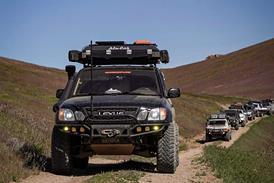

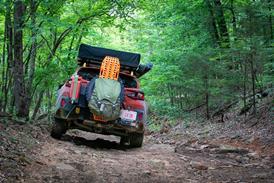
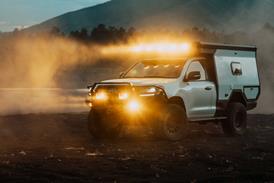
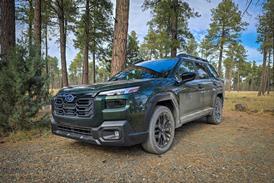
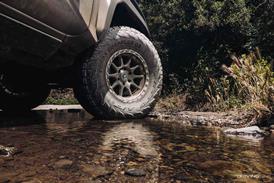

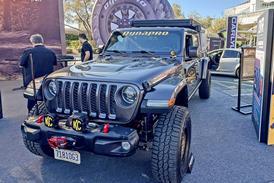
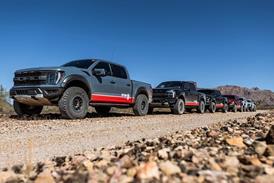
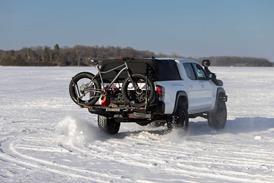


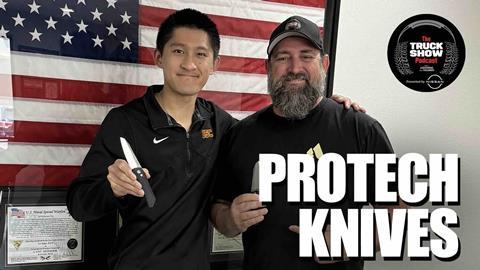






No comments yet